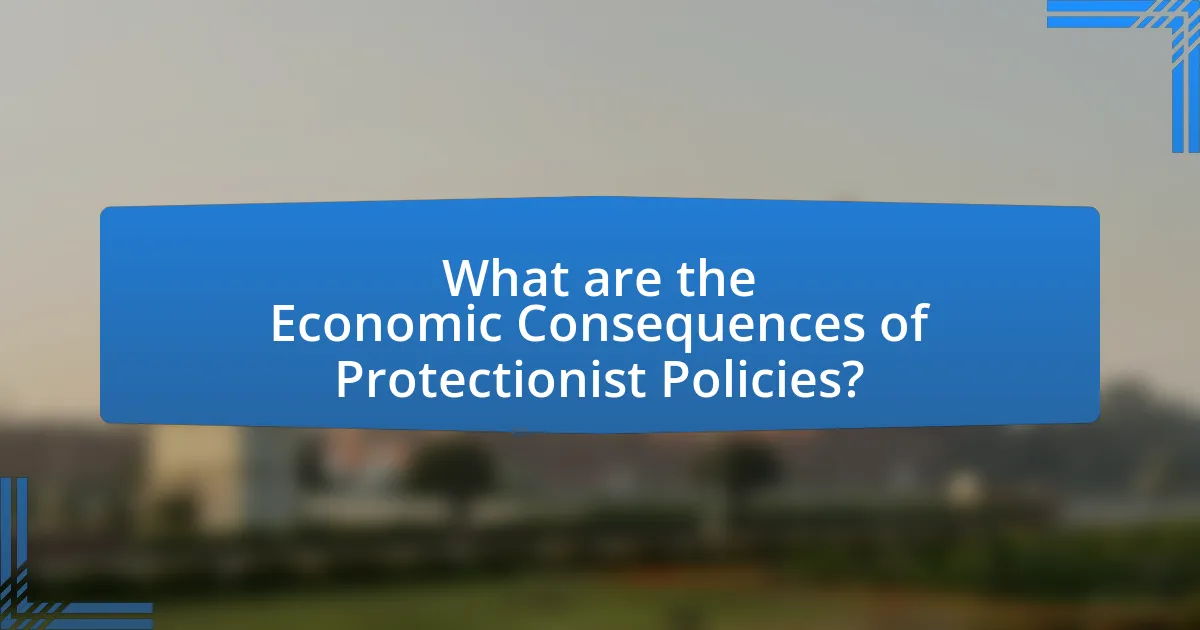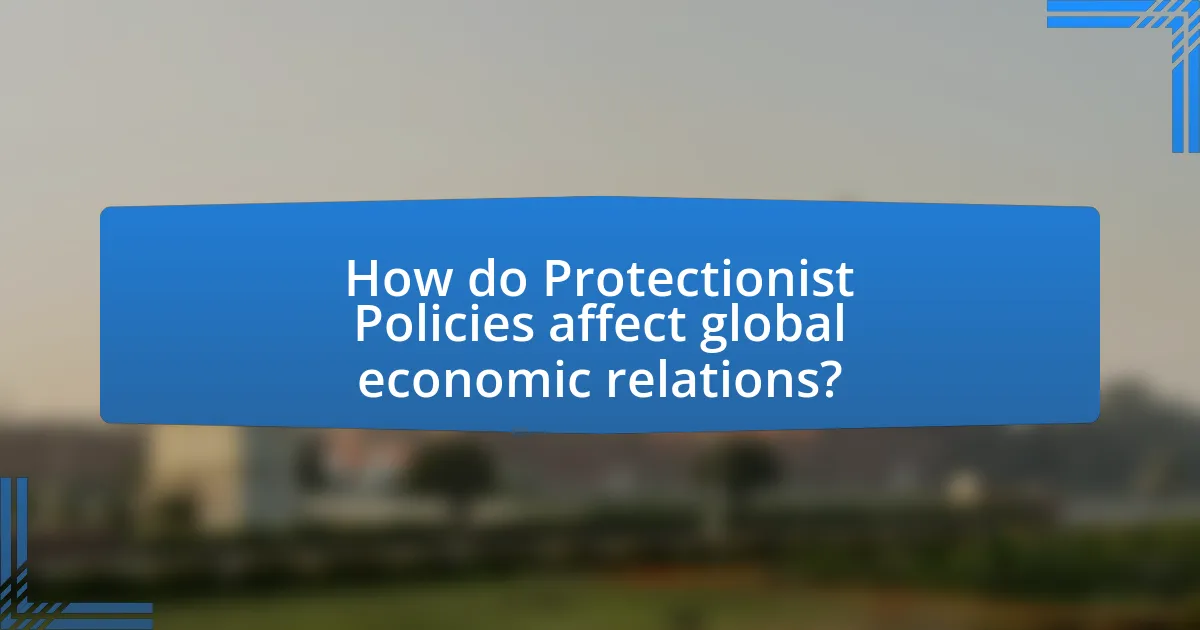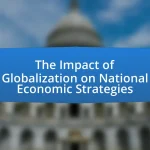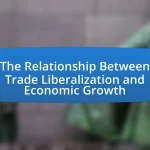Protectionist policies are government measures aimed at restricting international trade to safeguard domestic industries from foreign competition. This article examines the economic consequences of such policies, including their impact on international trade, domestic industries, and consumer prices. It outlines various types of protectionist measures, such as tariffs and quotas, and discusses the motivations behind their implementation, including political and economic factors. Additionally, the article explores the broader implications of protectionism on global economic relations, potential retaliatory actions from trading partners, and strategies countries can adopt to mitigate negative effects while balancing protectionism with free trade agreements.

What are Protectionist Policies?
Protectionist policies are government actions designed to restrict international trade to protect domestic industries from foreign competition. These policies often include tariffs, import quotas, and subsidies for local businesses. For example, the United States has implemented tariffs on steel and aluminum imports to support its domestic manufacturing sector, which illustrates how protectionist measures can be used to shield local economies from global market forces.
How do Protectionist Policies impact international trade?
Protectionist policies negatively impact international trade by imposing tariffs, quotas, and other trade barriers that restrict the flow of goods and services between countries. These measures lead to increased prices for consumers and reduced market access for exporters, ultimately resulting in lower trade volumes. For instance, the U.S.-China trade war, which began in 2018, saw both countries impose tariffs on billions of dollars’ worth of goods, leading to a significant decline in bilateral trade, which fell by approximately 15% in 2019. Additionally, protectionist policies can provoke retaliatory measures from trading partners, further escalating trade tensions and disrupting global supply chains.
What are the different types of Protectionist Policies?
Protectionist policies are government actions designed to restrict international trade to protect domestic industries. The main types of protectionist policies include tariffs, which are taxes imposed on imported goods to make them more expensive; quotas, which limit the quantity of a specific good that can be imported; subsidies, which provide financial support to local businesses to enhance their competitiveness; and non-tariff barriers, such as regulations and standards that make it difficult for foreign products to enter the market. These policies aim to safeguard local jobs and industries but can lead to trade disputes and higher prices for consumers.
How do tariffs function within Protectionist Policies?
Tariffs function within protectionist policies by imposing taxes on imported goods, thereby increasing their prices and making domestic products more competitive. This mechanism aims to protect local industries from foreign competition, encouraging consumers to purchase domestically produced goods. For instance, the United States implemented tariffs on steel and aluminum imports in 2018, which led to a rise in domestic production and prices for these materials. Such tariffs can also result in retaliatory measures from trading partners, impacting international trade dynamics and potentially leading to trade wars.
Why do countries implement Protectionist Policies?
Countries implement protectionist policies primarily to shield domestic industries from foreign competition. This is often done to protect jobs, promote local businesses, and maintain national security. For instance, tariffs on imported goods can make foreign products more expensive, encouraging consumers to buy domestically produced items. Historical examples include the Smoot-Hawley Tariff Act of 1930 in the United States, which raised tariffs on numerous imports to protect American industries during the Great Depression. Such measures can lead to short-term economic benefits for specific sectors, but they may also result in retaliatory actions from trading partners and higher prices for consumers.
What economic conditions lead to the adoption of Protectionist Policies?
Economic conditions that lead to the adoption of protectionist policies include high unemployment rates, trade deficits, and economic recessions. High unemployment often prompts governments to protect domestic industries to preserve jobs, as seen during the Great Depression when many countries implemented tariffs to shield local employment. Trade deficits, where a country imports more than it exports, can lead to protectionist measures to balance trade, as evidenced by the Smoot-Hawley Tariff Act of 1930 in the United States, which aimed to reduce imports and protect American businesses. Economic recessions create pressure on governments to adopt protectionist policies to stimulate local economies and safeguard national interests, as observed in various countries during financial crises.
How do political factors influence Protectionist Policies?
Political factors significantly influence protectionist policies by shaping government decisions on trade regulations and tariffs. Political ideologies, party agendas, and electoral pressures often drive leaders to adopt protectionist measures to safeguard domestic industries and jobs. For instance, during economic downturns, politicians may implement tariffs to protect local businesses from foreign competition, as seen in the United States during the 1930s with the Smoot-Hawley Tariff Act, which raised duties on imports to protect American agriculture and manufacturing. Additionally, lobbying from domestic industries can pressure governments to enact protectionist policies, reflecting the interests of influential stakeholders. This interplay between political motivations and economic strategies illustrates how political factors can lead to the adoption of protectionist measures, impacting international trade dynamics.

What are the Economic Consequences of Protectionist Policies?
Protectionist policies lead to several economic consequences, including reduced trade, higher consumer prices, and potential retaliation from trading partners. These policies, such as tariffs and import quotas, restrict foreign competition, which can protect domestic industries in the short term. However, they often result in inefficiencies, as domestic producers may lack the incentive to innovate or improve quality due to reduced competition. For instance, a study by the Peterson Institute for International Economics found that tariffs imposed during trade disputes can lead to a decrease in GDP growth and increased costs for consumers, as prices for imported goods rise. Additionally, protectionist measures can provoke retaliatory tariffs from other countries, further escalating trade tensions and harming global economic stability.
How do Protectionist Policies affect domestic industries?
Protectionist policies primarily benefit domestic industries by shielding them from foreign competition. These policies, such as tariffs and import quotas, create a favorable environment for local businesses to grow, as they reduce the influx of cheaper foreign goods. For instance, the U.S. steel industry saw a revival after the imposition of tariffs in 2018, which led to increased production and job creation within the sector. However, while protectionist measures can enhance the competitiveness of certain domestic industries, they may also lead to higher prices for consumers and retaliatory actions from trading partners, which can ultimately affect the overall economy.
What are the short-term benefits for local businesses?
Short-term benefits for local businesses include increased sales and market share due to reduced competition from foreign companies. Protectionist policies, such as tariffs and import quotas, create a more favorable environment for local businesses by limiting foreign imports, which can lead to higher demand for domestically produced goods. For instance, a study by the National Bureau of Economic Research found that tariffs on imported steel led to a temporary increase in domestic steel production and employment, benefiting local manufacturers. This immediate boost in sales and production can enhance cash flow and enable local businesses to invest in growth opportunities.
How do Protectionist Policies impact competition in the market?
Protectionist policies reduce competition in the market by limiting foreign competition through tariffs, quotas, and subsidies for domestic industries. These measures create an environment where domestic producers face less pressure to innovate or improve efficiency, as they are shielded from international competitors. For instance, the U.S. steel tariffs imposed in 2002 led to higher prices for consumers and reduced incentives for domestic steel companies to enhance productivity. Consequently, protectionist policies can lead to market inefficiencies, reduced consumer choice, and ultimately, a stagnation in economic growth.
What are the broader economic implications of Protectionist Policies?
Protectionist policies generally lead to reduced international trade, which can result in higher prices for consumers and inefficiencies in domestic industries. By imposing tariffs and quotas, governments protect local businesses from foreign competition, but this often stifles innovation and productivity. For instance, a study by the Peterson Institute for International Economics found that U.S. tariffs on steel and aluminum led to increased costs for American manufacturers, ultimately harming the economy by raising prices for consumers and reducing overall economic growth. Additionally, protectionism can provoke retaliatory measures from trading partners, further escalating trade tensions and potentially leading to trade wars, which can disrupt global supply chains and negatively impact economic stability.
How do Protectionist Policies influence consumer prices?
Protectionist policies increase consumer prices by imposing tariffs and quotas on imported goods, which reduces competition and raises costs for consumers. For instance, when the United States implemented tariffs on steel and aluminum in 2018, the prices of products using these materials, such as automobiles and construction supplies, rose significantly. A study by the National Bureau of Economic Research found that these tariffs led to an increase in consumer prices by approximately 0.3% to 0.5%. This price increase occurs because domestic producers, shielded from foreign competition, can charge higher prices without the pressure to lower them.
What is the effect on employment rates in various sectors?
Protectionist policies generally lead to varying effects on employment rates across different sectors. In industries such as manufacturing, protectionist measures like tariffs can initially boost domestic employment by reducing foreign competition, as evidenced by a 2018 study from the National Bureau of Economic Research, which found that tariffs on steel and aluminum led to a temporary increase in jobs in those sectors. Conversely, sectors reliant on exports or global supply chains, such as agriculture and technology, often experience job losses due to retaliatory tariffs and increased costs, as highlighted by the U.S. Chamber of Commerce, which reported significant job declines in agriculture following trade restrictions. Overall, while some sectors may benefit from protectionism in the short term, others face detrimental impacts, leading to a complex and uneven effect on overall employment rates.

How do Protectionist Policies affect global economic relations?
Protectionist policies negatively impact global economic relations by restricting trade and increasing tariffs, which leads to retaliatory measures from other countries. These policies create barriers to international commerce, resulting in reduced market access for exporters and higher prices for consumers. For instance, the U.S.-China trade war, initiated in 2018, saw both nations impose tariffs on billions of dollars’ worth of goods, disrupting supply chains and diminishing bilateral trade by approximately $100 billion in 2019 alone. Consequently, protectionist measures can lead to economic isolation, decreased foreign investment, and slower global economic growth.
What are the potential retaliatory measures from other countries?
Potential retaliatory measures from other countries include imposing tariffs, implementing trade barriers, and initiating legal disputes in international trade organizations. For instance, when the United States imposed tariffs on steel and aluminum imports in 2018, countries like Canada and the European Union responded with their own tariffs on U.S. goods, demonstrating a direct retaliatory action. Additionally, countries may engage in diplomatic negotiations or seek to form new trade agreements that exclude the offending nation, further illustrating the economic consequences of protectionist policies.
How do trade wars emerge from Protectionist Policies?
Trade wars emerge from protectionist policies when countries impose tariffs or quotas to shield domestic industries, leading to retaliatory measures from affected nations. For instance, when one country raises tariffs on imports, the targeted country often responds with its own tariffs, escalating tensions and resulting in a cycle of trade barriers. Historical examples include the Smoot-Hawley Tariff Act of 1930, which raised U.S. tariffs and prompted retaliatory tariffs from other countries, contributing to a global trade downturn. This cycle of protectionism can disrupt international trade relationships and harm global economic stability.
What long-term effects can arise from strained international relations?
Strained international relations can lead to long-term economic consequences, including reduced trade, increased tariffs, and diminished foreign investment. For instance, when countries impose tariffs in response to strained relations, it often results in retaliatory measures, which can decrease overall trade volumes. According to the World Trade Organization, a significant rise in tariffs can lead to a decline in global trade by as much as 10% over several years. Additionally, strained relations can create an unstable investment climate, discouraging foreign direct investment, which is crucial for economic growth. Historical examples, such as the U.S.-China trade tensions, illustrate how prolonged disputes can disrupt supply chains and lead to economic isolation, ultimately affecting domestic economies and global markets.
What strategies can countries adopt to mitigate negative effects?
Countries can adopt several strategies to mitigate the negative effects of protectionist policies, including diversifying trade partnerships, investing in domestic industries, and enhancing workforce skills. Diversifying trade partnerships allows countries to reduce reliance on a limited number of trading partners, thereby minimizing the impact of tariffs or trade barriers imposed by specific nations. For instance, countries like Canada have successfully expanded trade agreements with multiple nations to offset the effects of U.S. tariffs.
Investing in domestic industries can stimulate local economies and create jobs, which helps counteract the adverse effects of reduced foreign competition. For example, South Korea’s investment in technology and manufacturing has bolstered its economy despite global trade tensions.
Enhancing workforce skills through education and training programs prepares workers for shifts in the job market caused by protectionist measures. Countries such as Germany have implemented vocational training programs that align with industry needs, ensuring that their workforce remains competitive. These strategies collectively help countries navigate the challenges posed by protectionist policies while fostering economic resilience.
How can countries balance Protectionist Policies with free trade agreements?
Countries can balance protectionist policies with free trade agreements by implementing targeted tariffs and quotas while negotiating trade terms that allow for mutual benefits. This approach enables nations to protect key domestic industries from foreign competition, ensuring job security and economic stability, while simultaneously engaging in international trade to foster economic growth. For instance, the United States has utilized safeguard measures in trade agreements to protect specific sectors, such as steel and aluminum, while maintaining overall trade relationships with partners like Canada and Mexico through the USMCA. This strategy demonstrates that countries can selectively apply protectionist measures without entirely abandoning the principles of free trade, thus achieving a balance that supports both domestic interests and international cooperation.
What best practices can be implemented to support affected industries?
To support affected industries, implementing targeted financial assistance programs is essential. These programs can include grants, low-interest loans, and tax incentives specifically designed to help businesses recover from the impacts of protectionist policies. For instance, during the 2008 financial crisis, the U.S. government provided over $700 billion in financial assistance to stabilize key industries, demonstrating the effectiveness of such measures in mitigating economic downturns. Additionally, fostering workforce development through retraining programs can help employees transition into new roles within or outside their industries, as evidenced by the success of initiatives like the Trade Adjustment Assistance program, which has helped thousands of workers adapt to changing economic conditions.


